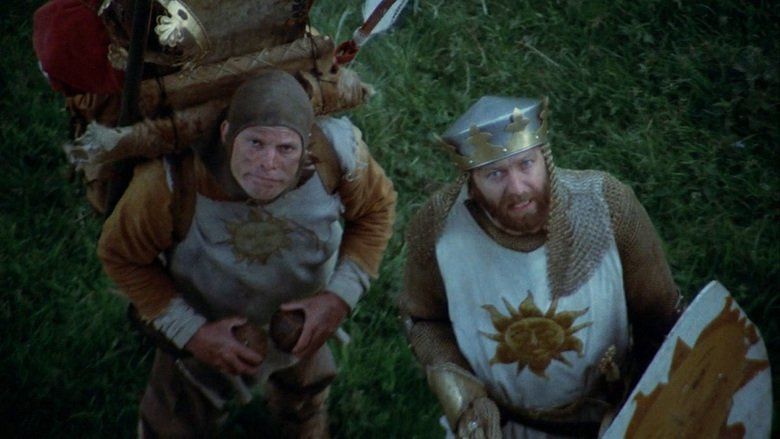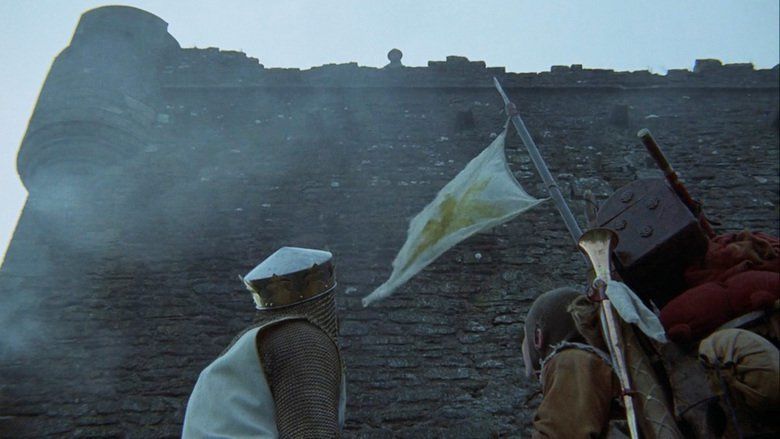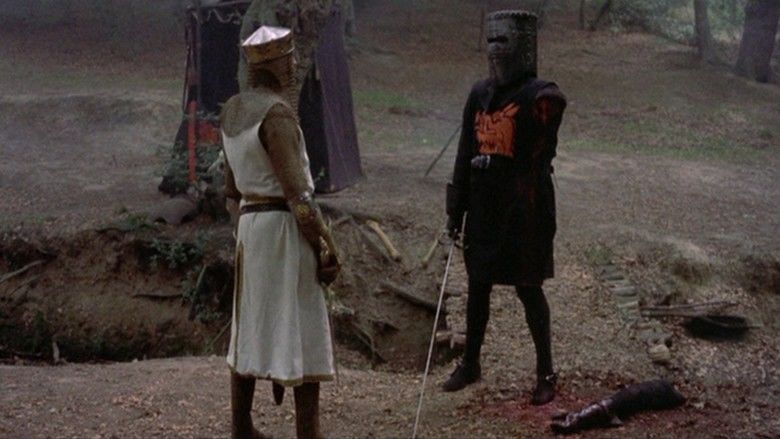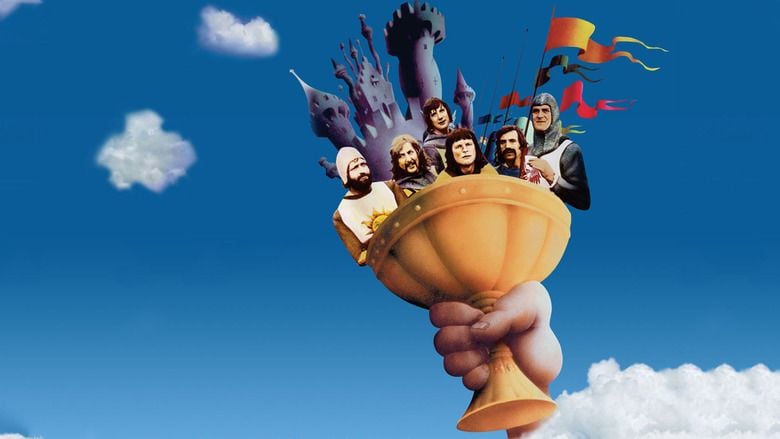Monty Python and the Holy Grail
9 /10 1 Votes
97% Rotten Tomatoes Country United Kingdom | 8.3/10 IMDb 90% Metacritic Genre Adventure, Comedy, Fantasy Duration Language English | |||||||||||||||||||||||||||||||||
 | ||||||||||||||||||||||||||||||||||
Director Terry GilliamTerry Jones Release date 9 April 1975 (1975-04-09) (London) Cast (King Arthur / Voice of God / Middle Head / Hiccoughing Guard), (Second Swallow-Savvy Guard / The Black Knight / Peasant 3 / Sir Lancelot the Brave / Taunting French Guard / Tim the Enchanter), (Dead Collector / Peasant 1 / Sir Robin the Not-Quite-So-Brave-as-Sir Launcelot / First Swamp Castle Guard / Concorde / Roger the Shrubber / Brother Maynard), (First Swallow-Savvy Guard / Dennis / Peasant 2 / Right Head / Sir Galahad the Pure / Narrator / King of Swamp Castle / Brother Maynard's Brother / Leader of The Knights Who Say NI!), Terry Gilliam (Patsy / Green Knight / Old Man from Scene 24 (Bridgekeeper) / Sir Bors / Animator / Gorrilla Hand), Terry Jones (Dennis's Mother / Sir Bedevere / Left Head / Prince Herbert / Cartoon Scribe (voice))Characters Arthur (Graham Chapman), Black Knight (John Cleese), Lancelot (John Cleese), Bedivere (Terry Jones), Green Knight (Terry Gilliam) Similar movies Tagline And now! At Last! Another film completely different from some of the other films which aren't quite the same as this one is. | ||||||||||||||||||||||||||||||||||
Monty python and the holy grail official trailer john cleese movie 1974
Monty Python and the Holy Grail is a 1975 British absurdist comedy film concerning the Arthurian legend, written and performed by the Monty Python comedy group (Graham Chapman, John Cleese, Terry Gilliam, Eric Idle, Terry Jones, and Michael Palin), and directed by Gilliam and Jones. It was conceived during the hiatus between the third and fourth series of their BBC television series Monty Python's Flying Circus.
Contents
- Monty python and the holy grail official trailer john cleese movie 1974
- Monty python and the holy grail
- Plot
- Development
- Filming
- Soundtrack
- Release
- Home media
- Reaction and legacy
- References

In contrast to the group's first film, And Now for Something Completely Different, a compilation of sketches from the first two television series, Holy Grail draws on new material. It parodies the legend of King Arthur's quest to find the Holy Grail. Idle used the film as the basis for the musical Spamalot 30 years later.

Monty Python and the Holy Grail grossed more than any British film exhibited in the US in 1975. The film received a 97% "Fresh" rating on Rotten Tomatoes. In the US, the film was selected as the second best comedy of all time in the ABC special Best in Film: The Greatest Movies of Our Time; in the UK, readers of Total Film magazine ranked the film the fifth greatest comedy film of all time, and a similar poll of Channel 4 viewers placed the film sixth (2000).

Monty python and the holy grail
Plot

The film opens with a credit sequence that becomes increasingly ridiculous, first becoming laden with strange pseudo-Swedish commentary about moose, and eventually being replaced with flashy titles in which everyone's name has been changed to something involving llamas.

The story proper begins in 932 A.D. (around 400 years later than an Arthurian tale should). King Arthur and his squire, Patsy, travel throughout Britain searching for men to join the Knights of the Round Table. Arthur stops at a castle, where the guards ask how Arthur found two coconut halves Patsy uses to simulate the sound of horses galloping. Arthur leaves after his encounter becomes a discussion about African and European swallows. Arthur encounters a Black Knight, who will not let them cross a small bridge. A sword fight ensues with Arthur gaining the upper hand, but the Black Knight continues fighting despite having his arms and legs severed. The Black Knight declares the battle a draw.

The villagers of a small town come to Sir Bedevere the Wise claiming they have captured a witch. Bedevere puts the woman through a test, and she is revealed to be a witch because she weighs the same as a duck. Arthur dubs Bedevere as a Knight of the Round Table, and they are later joined by Sir Lancelot the Brave, Sir Galahad the Pure, and Sir Robin the Not-Quite-So-Brave-as-Sir-Lancelot. The knights reach Camelot, but following a song-and-dance cutaway, Arthur decides not to enter, because "'Tis a silly place". The group encounters God, who instructs them to seek the Holy Grail.

Their first stop is a French-controlled castle. One of the soldiers tells the knights that they already have a grail, then taunts them with ridiculous insults. After a failed invasion of the castle, with the French soldiers throwing animals at them, the knights try sneaking into the castle in a Trojan Rabbit, but forget to hide inside it. The rabbit is catapulted at them and crushes one of the knights' servants. Arthur decides the group should split up to seek the grail. A modern-day historian, describing the Arthurian legends, is abruptly killed by a knight on horseback, triggering a police investigation.

The knights encounter various perils. Arthur and Bedevere attempt to satisfy the strange requests of the dreaded Knights Who Say Ni. Sir Robin avoids a fight with the Three-headed Giant by running away while the heads are arguing. Sir Galahad is led by a grail-shaped beacon to Castle Anthrax, populated by women who wish to perform sexual favours for him, but to Galahad's chagrin, he is "rescued" by Lancelot. Sir Lancelot finds a note tied to an arrow, and after reading it assaults a wedding party at Swamp Castle, believing them to be holding a lady against her will. He discovers that an effeminate prince sent the note, and there's another song-and-dance routine.
The knights regroup and are joined by Sir Gawain, Sir Ector, and Sir Bors, and a group of monks led by Brother Maynard. They encounter Tim the Enchanter, who points them to caves where the location of the grail is written. To enter the caves, the group must defeat the Rabbit of Caerbannog. After the rabbit kills Gawain, Ector and Bors during a failed attack, Brother Maynard provides the Holy Hand Grenade of Antioch, which Arthur uses to kill the rabbit. The knights enter the cave and find an inscription written by Joseph of Arimathea, which states that the Grail can be found in the "Castle of Aarrgh". The group is attacked by the Legendary Black Beast of Aarrgh, which devours Brother Maynard. Arthur and his knights escape when the beast's animator suffers a fatal heart attack.
The group travels to the Bridge of Death, where each knight must answer three questions from the bridge-keeper before proceeding. Lancelot easily answers his questions and crosses the bridge. Robin is confounded by a difficult question while Galahad gives a wrong answer to an easy one and both are hurled into the Gorge of Eternal Peril. Arthur responds to the bridge-keeper's question with another one and the bridge-keeper is thrown into the chasm for not knowing the answer.
Lancelot is separated from Arthur and Bedevere, then arrested by the police investigating the historian's murder. Arthur and Bedevere travel to the Castle Aarrgh, which they find occupied by the French forces that taunted them earlier. They amass a large army and prepare to storm the castle, but just as they begin to charge, the modern police arrive. Arthur and Bedevere are arrested, and one of the officers covers the lens with his hand, as the film breaks in the projector.
Development
Fifteen months before BBC visited the set in December 1974, the Monty Python troupe assembled the first version of the screenplay. When half of the resulting material was set in the Middle Ages, and half was set in the present day, the group opted to focus on the Middle Ages, revolving on the legend of the Holy Grail. By the fourth or fifth version of their screenplay, the story was complete, and the cast joked the fact that the Grail was never retrieved would be "a big let-down ... a great anti-climax". Graham Chapman said a challenge was incorporating scenes that did not the Holy Grail motif.
Neither Terry Gilliam nor Terry Jones had directed a film before, and described it as a learning experience in which they would learn to make a film by making an entire full-length film. The cast humorously described the novice directing style as employing the level of mutual disrespect always found in Monty Python's work.
Filming
Monty Python and the Holy Grail was mostly shot on location in Scotland, particularly around Doune Castle, Glen Coe, and the privately owned Castle Stalker. The many castles seen throughout the film were mainly either Doune Castle shot from different angles or hanging miniatures. There are several exceptions to this: the very first exterior shot of a castle at the beginning of the film is Kidwelly Castle in South Wales, and the single exterior shot of the Swamp Castle during "Tale of Sir Lancelot" is Bodiam Castle in East Sussex; all subsequent shots of the exterior and interior of those scenes were filmed at Doune Castle. Production designer Julian Doyle recounted that his crew constructed walls in the forest near Doune. Terry Jones later recalled the crew had selected more castles around Scotland for locations, but during the two weeks prior to principal photography, the Scottish Department of the Environment declined permission for use of the castles in its jurisdiction, for fear of damage.
At the start of "The Tale of Sir Robin", there is a slow camera zoom in on rocky scenery (that in the voice over is described as "the dark forest of Ewing"). This is actually a still photograph of the Gorge at Mount Buffalo National Park in Victoria, Australia. Doyle stated in 2000 during an interview with Hotdog magazine that it was a still image filmed with candles underneath the frame (to give a heat haze). This was a low-cost method of achieving a convincing location effect.
On the DVD audio commentary, Cleese described challenges shooting and editing Castle Anthrax in "The Tale of Sir Galahad", with what he felt the most comedic take being unused because an anachronistic coat was visible in it. Castle Anthrax was also shot in one part of Doune, where costume designer Hazel Pethig advised against nudity, dressing the girls in shifts.
In the scene where the knights were combatting the Rabbit of Caerbannog, a real white rabbit was used, switched with puppets for its killings. It was covered with red liquid to simulate blood, though the rabbit's owner did not want the animal dirty and was kept unaware. The liquid was difficult to remove from the fur. He also stated that he thought that, had they been more experienced in filmmaking, the crew would have just purchased a rabbit instead. Otherwise, the rabbit himself was unharmed. Also, the rabbit-bite effects were done by special puppetry by both Gilliam and SFX technician John Horton.
As chronicled in The Life of Python, The First 20 Years of Monty Python, and The Pythons' Autobiography, it was revealed that Chapman was suffering from acrophobia, trembling, and bouts of forgetfulness during filming. These were the results of Chapman's long-standing alcohol addiction, and he decided from that moment on to remain "on an even keel" while the production continued. Nearly three years after Holy Grail, Chapman vowed to quit drinking altogether (which he successfully achieved in December 1977).
Originally the knight characters were going to ride real horses, but after it became clear that the film's small budget precluded real horses, the Pythons decided that their characters would mime horse-riding while their porters trotted behind them banging coconut shells together. The joke was derived from the old-fashioned sound effect used by radio shows to convey the sound of hooves clattering. This was later referred to in the German release of the film, which translated the title as Die Ritter der Kokosnuß ('The Knights of the Coconut').
The opening credits of the film feature pseudo-Swedish subtitles, which soon turn into an appeal to visit Sweden and see the country's moose. The subtitles are soon stopped, but moose references continue throughout the actual credits until the credits are stopped again and restarted in a different visual style and with references to llamas, animals often mentioned in Flying Circus. The subtitles were written by Michael Palin as a way to "entertain the 'captive' audience" at the beginning of the film.
Soundtrack
In addition to several songs written by Python regular Neil Innes, several pieces of music were licensed from De Wolfe Music Library. These include:
Release
Monty Python and the Holy Grail had its theatrical debut in the United Kingdom in 3 April 1975, followed by a United States release on 27 April 1975. It was re-released on 14 October 2015 in the United Kingdom.
The film had its television premiere 25 February 1977 on the CBS Late Movie. Reportedly, the Pythons were displeased to discover a number of edits were done by the network to reduce use of profanity and the showing of blood. The troupe pulled back the rights and thereafter had it broadcast in the United States only on PBS and later other channels such as IFC, where it runs uncut.
Home media
In Region 1, The Criterion Collection released a laserdisc version of the film featuring audio commentary from directors Jones and Gilliam. In 2001, Columbia Tristar published a two-disc Special Edition DVD. Disc One included two commentary tracks featuring Idle, Palin, and Cleese in the first, and Jones and Gilliam in the second, and "Subtitles for People Who Don't Like the Film", consisting of lines taken from William Shakespeare's Henry IV, Part 2. Disc Two includes Monty Python and the Holy Grail in Lego (also known as Lego Knights or It's Only a Model), a "brickfilm" version of the "Camelot Song" as sung by Lego minifigures. It was created by Spite Your Face Productions on commission from the Lego Group and Python Pictures. The project was conceived by the original film's respective Producer and Co-Director, John Goldstone and Terry Gilliam. Disc Two also includes two scenes from the film's Japanese dub, literally translated back into English through subtitles. "The Quest for the Holy Grail Locations", hosted by Palin and Jones, shows places in Scotland used for the setting titled as "England 932 A.D." (as well as the two Pythons purchasing a copy of their own script as a guide). Also included is a who's who page, advertising galleries and sing-alongs.
A limited-edition DVD release additionally included a copy of the screenplay, a limited-edition film cell/senitype, and limited-edition art cards; however, a few of the bonus features from the Extraordinarily Deluxe Edition were omitted. A 35th anniversary edition on Blu-ray was released in the US on 6 March 2012. Special features include "The Holy Book of Days," a second-screen experience that can be downloaded as an app on an iOS device and played with the Blu-ray to enhance its viewing; lost animation sequences with a new intro from animator Terry Gilliam; outtakes; and extended scenes with Python member and the movie's co-director Terry Jones.
Reaction and legacy
In 2000, readers of Total Film magazine voted Holy Grail the fifth greatest comedy film of all time. The next Python film, Life of Brian, was ranked first. A similar poll of Channel 4 viewers in 2005 placed Holy Grail in sixth (with Life of Brian again topping the list).
In 2005, the film spawned a Tony Award-winning Broadway musical smash hit knockoff, Spamalot. Written primarily by Idle, the show has more of an overarching plot and leaves out certain portions of the movie due to difficulties in rendering certain effects on stage. However, the same gags are there for the majority of the show.
In 2011, an ABC prime-time special, Best in Film: The Greatest Movies of Our Time, counted down the best films chosen by fans based on results of a poll conducted by ABC and People. Holy Grail was selected as the second best comedy after Airplane!.
In 2013, the Pythons lost a legal case to Mark Forstater, the film's producer, over royalties for the derivative work, Spamalot. They owed a combined £800,000 in legal fees and back royalties to Forstater. To help cover the cost of these royalties and fees, the group arranged and performed in a stage show, Monty Python Live (mostly), held at The O2 arena in London in July 2014.
References
Monty Python and the Holy Grail WikipediaMonty Python and the Holy Grail IMDbMonty Python and the Holy Grail Rotten TomatoesMonty Python and the Holy Grail MetacriticMonty Python and the Holy Grail themoviedb.org
